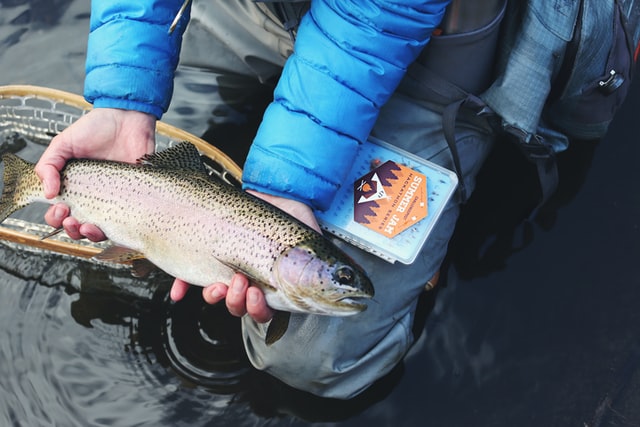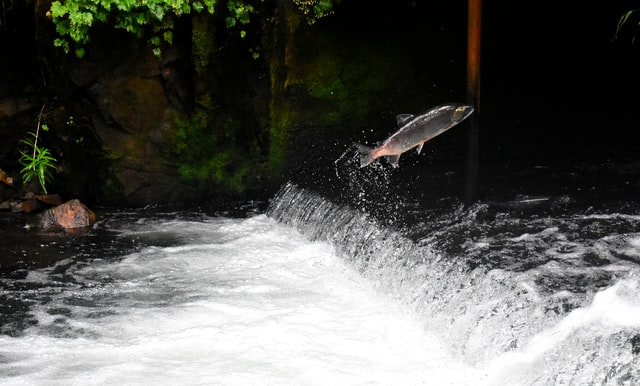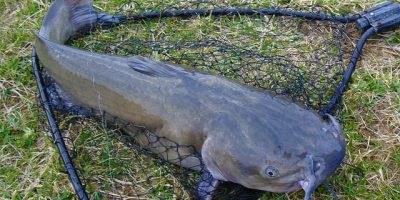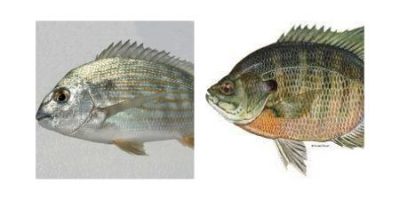Many fish species rely on migration up and down rivers for survival. Dams, culverts, and waterfalls in rivers have the ability to delay or stop fish movement. Indeed, obstacles to fish migration are frequently blamed for the collapse of some fish stocks. A fish ladder, sometimes known as a fishway, provides a diversion path for migrating fish around a river barrier.
How Does the Fish Ladder Function?

It creates a long, descending channel for fish to go around the barrier by using a succession of tiny dams and pools of uniform length. The channel functions as a set lock, slowly lowering the water level; to get upstream, fish must hop from box to box in the ladder. It provides a diversion path for migrating fish to go over or around a dam that is impeding their migration.
There is a sequence of rising pools that are accessed by swimming against a torrent of water rather than climbing rungs.
A fish ladder, sometimes known as a fishway, is designed to assist migrating fish in navigating around dams that would otherwise prevent access to hatching habitat. A spillway is essentially intended to enable part of the water to escape the dam, allowing the fish to swim up and over.
Various Types of Fish Ladders
➖The Pool Ladder
A pool and weir fishway, often known as a fish ladder, is a well-known fish pass construction. It is made up of a series of minor overflow weirs and ponds of varying lengths. The pools are built in the shape of stairs, and they are separated by overflow weirs.
To move upstream, fish must jump from one pool to another. It is appropriate for all sorts of constructions, whether tiny or vast in scale. They do, however, need a considerable amount of room to be built.
➖The Vertical Slot Fish Ladder
Another type of pool and weir fishway is the vertical slot fishway. In this scenario, the weirs are replaced with walls with vertical slots, allowing the fish to readily travel from pool to pool and upstream.
Numerous vertical slots are also available in some circumstances. Vertical space fish ladders permit the fish to swim at the deepness they desire. Where there is a lot of fish migration in the river, this style of fish ladder is ideal.
➖The Baffle Fishway
Another type of fishway is the baffle fishway, which is a rectangular canal with a series of uniformly spaced baffles parallel to the flow direction. In general, unlike pool-type fish ladders, water flows continuously via baffle fishways without stopping; however, pools can be constructed between those baffle walls if necessary.
➖The Rock Ramp Fishway
Large boulders and timber logs are used to construct rock ramp fishways. In this form of the fishway, a rock ramp is built precisely over the obstruction’s width, with a little incline. These big boulders form pools and fall in such a way that fish may easily pass over them.
Low-height weirs, short waterfalls, and channel strengthening structures are examples of rock ramp fishways that are ideally suited for low height impediments when upstream water level management is not required.
➖The Fish Elevator
Fish elevators, also known as fish lifts, are another form of a fishway in which fish are hoisted from downstream to upstream by a water-filled chamber. Fish lifts are ideal for towering barriers like arch dams and high weirs.
When compared to ladder-type fish passes, the fish elevator allows for a large number of fish to migrate at the same time. Due to the sheer tiny size of the openings and their weak swimming ability, several large-sized species may be unable to migrate upstream via ladder-type crossings. Fish elevators are ideal for this sort of animal.
➖The Siphon Fishway
A fish siphon, also known as a siphon fishway, is a closed fish passageway that connects two bodies of water. The fish joins the siphon tube, which is partly loaded with water and where the flow speed is managed by the siphon effect.
The fish siphon allows various sizes of species to pass through and is laid out with minor gradients. It is optimal for fish migration during flood seasons. The graphic below shows the apertures within the fish siphon.
Effectiveness of Fish Ladders
The efficiency of fish ladders has been varied. They varied in efficacy for various species, with one research finding that just 3% of American Shad make it through all of the fish ladders on their route to spawning grounds.
The effectiveness is determined by the capacity of the fish species to swim and how the fish goes up and downstream. A fish channel built to allow fish to flow upstream may not allow fish to cross downstream, for example.
Fish passageways are not usually effective. Connecting swimming performance information to hydrodynamic measures is a difficulty in practice.
Swim tests almost seldom follow the same technique, and the results are either a single-point estimate or a bulk velocity. Physical and numerical modeling of fluid flow, on the other hand, produces a precise flow map with fine spatial and temporal resolution.
Matching hydrodynamic measurements with swimming performance data is a challenging undertaking for regulatory organizations.
Why some Fish Swim Upstream

Other fish travel upstream because it is a necessary element of their reproductive cycle. Salmon, for example, are born in freshwater rivers, spend the majority of their life in the ocean, and then return to deposit their eggs.
Swimming upstream is a sort of migration as well as a means of ensuring that their young endure long enough to develop into adults. The road is difficult, but it leads to healthy salmon populations on which animals and people rely for sustenance.
The primary reason salmon swim upstream is to secure their offspring’s survival. This fish spawning behavior is what allows salmon to successfully carry along their genes.
Young salmon absorb the fragrance of their home stream as they hatch. They may even recall certain odors as they travel downstream and towards the ocean. Even if they have been absent for many years, when these salmon go back to their birthplace as adults, they will utilize those scents to “test the waters” and locate their home stream.
If they swim up the incorrect river, the friendly aroma fades and they return to test another stream.
Big Advantages of Dams
❕ Provides Energy Source
Hydroelectricity accounts for 19% of the world’s power supply. Dams may generate power because the kinetic power of the water flow causes turbines to rotate.
That is how it is able to create clean and renewable power. Once the dam is completed, there will be no need to rely on fossil fuels to provide the energy required to maintain a contemporary lifestyle.
❕ Helps Retain Water Supply
When humans take advantage of the possibility of a dam a river, the water pools to form a pool behind the building. This result enables the region’s population centers to gather freshwater during periods of significant precipitation for usage during a dry spell or drought.
This technical wonder is also used to control flooding or to deliver a set volume of fluid to adjacent areas for agricultural irrigation. That is, a dam may protect a whole region from extreme weather events or erratic precipitation patterns.
❕ Offers Vital Leisure Possibilities
Dams may bring several economic, environmental, and social benefits. There are several reservoirs where you may enjoy camping, boating, and waterskiing. It provides a location for a boat launch that supports commercial fishing activity in areas that would not otherwise have access to water.
❕ Can Control Flood
Dams aid in the prevention of property damage while also lowering the danger of human death from yearly flooding occurrences. These barriers can impound floodwaters into the basin behind the dam, enabling us to regulate them or store them for future use.
It has the potential to redirect excess precipitation toward towns for fresh drinking water, increase irrigation options, and address a number of energy-related demands.
❕ Can Offer a Solid Navigation System
Dams on rivers can be used to establish a steady system of inland water transportation. Installing a lock system using this technology gives a safe area for the community to transfer products as well as a number of other advantages.
Dams can potentially provide better environmental protection in specific cases. This device is capable of retaining dangerous items or decreasing the impact of sedimentation on susceptible rivers.
❕ May be Used to Providing Drinking Water
We may utilize the freshwater preserved behind a dam in a pool as a reserve of drinking water for neighboring towns and cities since it is held behind a dam in a reservoir.
Large trenches, lines, and other modes of transportation may be used to guarantee that every residence has a connection to safe and sanitary drinking water.
❕ Can Provide a Habitat for Certain Fish
Dams can provide a safe haven for some kinds of fish. Dams can protect them from predators that might otherwise threaten their species. It is a safe and regulated setting, and the number of fish released into the wild may be determined based on how extinct the species is.
It is a more stable living environment that can assist them in surviving and thriving. Dams can be beneficial to fish that swim upstream. They will be able to lay their eggs in a protected location away from predators.
Types of Fish that Uses the Fish Ladder

🐟Salmon
This is most likely the preferably upstream swimming fish that comes to mind for most people. The Atlantic Salmon, the most common type of salmon, can be found largely on the Pacific’s West Coast. Salmon is a lovely, slender fish with a modest face that may weigh up to 57 pounds.
Schools of these fish will migrate up rivers that link to the Pacific, returning to their birthplace to reproduce. The salmon will usually live to spawn again the following year.
🐟American Shad
It is endemic to Northern America and is known as George Washington’s favored fish. This lovely silvery fish has a greenish line down its back and black markings on its shoulders. It has a short body from back to belly and a long body from head to tail.
Aside from its appearance on plates, this fish is unique in that it can move upstream from coastal waters to its source and re-spawn numerous times.
🐟Spotted Seatrout
Despite its expression, it is not a trout; rather, it is a member of the drum family, Sciaenidae. On dull days on the sea, fishermen admire the fish because they will bite when nothing else would.
The fish is aboriginal to the East Coast, occupying waters from the Gulf of Mexico to the Massachusetts Cape Cod shore; the species does not flourish beyond Delaware. They do not flourish in cold conditions, and warm temperatures cause them to reproduce.
Between May and September, seatrout begins to spawn and migrate to the rivers where they were born.
🐟Hilsa
It is native to the eastern shores of the world, provides a substantial quantity of food in India, and is Bangladesh’s honorary fish. Hilsa is a widespread species found in seaside waters from the Arabian Sea to the Bay of Bengal.
During migratory times, the Hilsa migrates from seawater to freshwater. These migratory phases occur twice a year, once during the typhoon season and once during the winter season.
🐟Sturgeon
The Sturgeon fish is beautiful to look at and comes in a variety of sizes. It can weigh as little as 20 pounds and as much as 2,500 pounds. Scutes, or bone plates, cover their heads, and their bodies are covered in similar vertebrae.
These plates run down the sides of their bodies in around five horizontal rows. Their tails are identical to sharks’, and they, too, have a cartilaginous skeleton. The fin’s top lobe is more extended than the bottom. They can only be found in the Northern Hemisphere, usually in the ocean; however, certain species can only be found in freshwater.
Great Advantages of Eating Fish
Fish is one of the world’s healthiest foods. It’s high in essential nutrients including protein and vitamin D. Fish is also high in omega-3 fatty acids, which are essential for your body and brain.
👍High in Nutrients
Fish is high in several vitamins that most people lack. Fatty species are sometimes thought to be the healthiest. This is because fatty fish have more fat-based nutrients.
Fatty fish is also high in omega-3 fatty acids, which are essential for the good body and brain process and have been connected to a lower risk of numerous ailments.
👍Lower Risks of Heart Attacks and Strokes
Heart attacks and strokes are the two highest causes of mortality around the world. Fish is considered one of the most heart-healthy foods known. There is a great number of big observational studies demonstrating that persons who ingest fish regularly had a lowered risk of heart attacks and strokes.
And because of their high omega-3 fatty acid content, researchers believe that fatty forms of fish are even more beneficial for heart health.
👍It has Nutrients Needed for Growth
Omega-3 fatty acids are required for proper growth and development. And omega-3 fatty acids are very crucial for brain and ocular development. As a result, pregnant and nursing women are typically instructed to consume enough amounts of omega-3 fatty acids.
👍Boosts Brain Health
As you become older, your brain process tends to degenerate. While the minor cognitive loss is natural, major neurodegenerative diseases are not. Many observational studies demonstrate that people who devour more fish age at a slower pace.
👍May Improve Sleep
Sleep issues have grown quite frequently all around the world. Increased blue light exposure may have a role, although some experts believe vitamin D insufficiency may also play a role.
👍Easy to Prepare
Fish is both tasty and simple to cook. As a result, including it in your diet should be rather simple. Eating fish once or twice a week is thought to be adequate to get the advantages. Salmon, for example, can be roasted, fried, grilled, or boiled. It goes nicely with a wide variety of vegetables and grains.
Frequently Asked Questions
Q: How can fish cross dams?
A: The dams contain fish ladders for mature fish and can pass fish via spillways. Three of the four dams eventually had juvenile fish gathering facilities constructed.
Q: What problem can fish ladders solve?
A: Many dams contain fish transit facilities and fish ladders to assist young and adult fish in migrating around them.
Q: Why are dams harmful to fish?
A: Dams prevent fish from migrating along their normal routes between feeding and spawning areas, disrupting their life cycles and limiting their ability to reproduce.
Q: Is it possible for fish to swim up a dam?
A: To some extent, all fish migrate, but dams are the most disruptive influence.
Q: Where can I find the fish ladder?
A: Along significant fish migratory pathways, there are fish ladders. These constructions are found mostly in waterways.
Q: How long does a salmon take to swim upstream?
A: On average, salmon take two to three weeks to migrate upstream to their breeding grounds. Of fact, the length of time relies heavily on the river system through which the salmon pass.
Final Thoughts
The design of a fish ladder varies based on the blockage, river flow, and kind of fish impacted, but the main idea is the same: the ladder has a succession of increasing pools that are accessed by swimming against a stream of water. Fish jump into the rushing water, rest in a pool and then repeat the procedure until they reach the top of the ladder.


